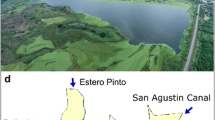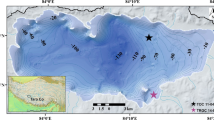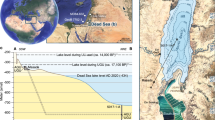Abstract
Sediments in Lower Murray Lake, northern Ellesmere Island, Nunavut Canada (81°21′ N, 69°32′ W) contain annual laminations (varves) that provide a record of sediment accumulation through the past 5000+ years. Annual mass accumulation was estimated based on measurements of varve thickness and sediment bulk density. Comparison of Lower Murray Lake mass accumulation with instrumental climate data, long-term records of climatic forcing mechanisms and other regional paleoclimate records suggests that lake sedimentation is positively correlated with regional melt season temperatures driven by radiative forcing. The temperature reconstruction suggests that recent temperatures are ~2.6°C higher than minimum temperatures observed during the Little Ice Age, maximum temperatures during the past 5200 years exceeded modern values by ~0.6°C, and that minimum temperatures observed approximately 2900 varve years BC were ~3.5°C colder than recent conditions. Recent temperatures were the warmest since the fourteenth century, but similar conditions existed intermittently during the period spanning ~4000–1000 varve years ago. A highly stable pattern of sedimentation throughout the period of record supports the use of annual mass accumulation in Lower Murray Lake as a reliable proxy indicator of local climatic conditions in the past.











Similar content being viewed by others
References
Anderson RK, Miller GH, Briner JP, Lifton NA, DeVogel SB (2008) A millennial perspective on Arctic warming from 14C in quartz and plants emerging from beneath ice caps. Geophys Res Lett 35. doi:10.1029/2007GL032057
Appleby PG, Oldfield F (1978) The calculation of 210Pb dates assuming a constant rate of supply of unsupported 210Pb to the sediment. Catena 5:1–8. doi:10.1016/S0341-8162(78)80002-2
Besonen MR, Patridge W, Bradley RS, Francus P, Stoner J, Abbott M (2008) A record of climate over the last millennium based on varved lake sediments from the Canadian High Arctic. Holocene 18:169–180. doi:10.1177/0959683607085607
Blass A, Grosjean M, Troxler M, Sturm M (2007) How stable are twentieth-century calibration models? A high-resolution summer temperature reconstruction for the eastern Swiss Alps back to AD 1580 derived from proglacial varved sediments. Holocene 17:51–63. doi:10.1177/0959683607073278
Braun C, Hardy DR, Bradley RS, Retelle MJ (2000a) Streamflow and suspended sediment transfer to Lake Sophia, Cornwallis Island, Nunavut, Canada. Arct Antarct Alp Res 32:45–465. doi:10.2307/1552395
Braun C, Hardy DR, Bradley RS, Retelle MJ (2000b) Hydrological and meteorological observations at Lake Tuborg, Ellesmere Island, Nunavut, Canada. Polar Geog 24:83–97
Cockburn JMH, Lamoureux SF (2007) Hydroclimate controls over seasonal sediment yield in two adjacent High Arctic watersheds. Hydrol Process. doi:10.1001/hyp.6798
Cockburn JMH, Lamoureux SF (2008) Inflow and lake controls on short-term mass accumulation and sedimentary particle size in a High Arctic lake: implications for interpreting varve lacustrine sedimentary records. J Paleolimnol. doi:10.1007/s10933-008-9207-5
Crowley TJ (2000) Causes of climate change over the past 1000 years. Science 289:270–277. doi:10.1126/science.289.5477.270
Dean WEJ (1974) Determination of carbonate and organic matter in calcareous sediments and sedimentary rocks by loss on ignition: comparison with other methods. J Sediment Petrol 44:242–248
Durre M, Russell SV, David BW (2006) Overview of the integrated global radiosonde archive. J Clim 19:53–68. doi:10.1175/JCLI3594.1
England J (1983) Isostatic adjustments in a full glacial sea. Can J Earth Sci 20:895–917
Esper JE, Frank DC, Wilson RJS, Briffa KR (2005) Effect of scaling and regression on reconstructed temperature amplitude for the past millennium. Geophys Res Lett 32. doi:10.1029/2004GL021236
Fisher DA, Koerner RM (1994) Signal and noise in four ice-core records from the Agasiiz Ice Cap, Ellesmere Island, Canada: details of the last millennium for stable isotopes, melt and solid conductivity. Holocene 4:113–120. doi:10.1177/095968369400400201
Fisher DA, Koerner RM, Paterson WSB, Dansgaard W, Gundestrup N, Reeh N (1983) Effect of wind scouring on climatic records from ice-core oxygen-isotope profiles. Nature 301:205–209. doi:10.1038/301205a0
Fisher DA, Koerner RM, Reeh N (1995) Holocene climatic records from Agassiz Ice Cap, Ellesmere Island, NWT, Canada. Holocene 5:19–24. doi:10.1177/095968369500500103
Forbes AC, Lamoureux SF (2005) Climatic controls on streamflow and suspended sediment transport in three large Middle Arctic catchments, Boothia Peninsula, Nunavut Canada. Arct Antarct Alp Res 37:304–315. doi:10.1657/1523-0430(2005)037[0304:CCOSAS]2.0.CO;2
Francus P, Asikainen C (2001) Sub-sampling unconsolidated sediments: a solution for the preparation of undisturbed thin-sections from clay-rich sediments. J Paleolimnol 26:323–326. doi:10.1023/A:1017572602692
Francus P, Bradley RS, Abbott MB, Patridge W, Keimig F (2002) Paleoclimate studies of minerogenic sediments using annually resolved textural parameters. Geophys Res Lett 29. doi:1029/2002GL015082
Francus P, Bradley RS, Lewis T, Abbott MB, Retelle M, Stoner JS (2008) Limnological and sedimentary processes at Sawtooth Lake, Canadian High Arctic, and their influence on varve formation. J Paleolimnol. doi:10.1007/s10933-008-9210-x
Gajewski K, Atkinson DA (2003) Climatic change in northern Canada. Environ Rev 11:69–102. doi:10.1139/a03-006
Gajewski K, Hamilton PB, McNeely R (1997) A high resolution proxy-climate record from an arctic lake with annually-laminated sediments on Devon Island, Nunavut, Canada. J Paleolimnol 17:215–225. doi:10.1023/A:1007984617675
Hambley GW, Lamoureux SF (2006) Recent summer climate recorded in complex varved sediments, Nicolay Lake, Cornwall Island, Nunavut, Canada. J Paleolimnol 35:629–640. doi:10.1007/s10933-005-4302-3
Hardy DR (1996) Climatic influences on streamflow and sediment flux into Lake C2, Northern Ellesmere Island, Canada. J Paleolimnol 16:133–149
Hardy DR, Bradley RS, Zolitschka B (1996) The climatic signal in varved sediments from Lake C2, northern Ellesmere Island, Canada. J Paleolimnol 16:227–238
Heiri O, Lotter AF, Lemcke G (2001) Loss on ignition as a method for estimating organic and carbonate content in sediments: reproducibility and comparability of results. J Paleolimnol 25:101–110. doi:10.1023/A:1008119611481
Hodder KR, Gilbert R, Desloges JR (2007) Glaciolacustrine varved sediment as an alpine hydroclimatic proxy. J Paleolimnol 38:365–394. doi:10.1007/s10933-006-9083-9
Holland MM, Bitz CM (2003) Polar amplification of climate change in coupled models. Clim Dyn 21:221–232. doi:10.1007/s00382-003-0332-6
Hughen KA, Overpeck JT, Anderson RF (2000) Recent warming in a 500-year palaeotemperature record from varved sediments, Upper Soper Lake, Baffin Island, Canada. Holocene 10:9–19. doi:10.1191/095968300676746202
Koerner RM, Fisher DA (1990) A record of Holocene summer climate from a Canadian high-Arctic ice core. Nature 343:630–631. doi:10.1038/343630a0
Koerner RM, Paterson WSB (1974) Analysis of a core through the Meighen Ice Cap, Arctic Canada, and its paleoclimatic implications. Quat Res 4:254–263. doi:10.1016/0033-5894(74)90015-5
Lamoureux SF (1999) Spatial and interannual variations in sedimentation patterns recorded in nonglacial varved sediments from the Canadian High Arctic. J Paleolimnol 21:73–84. doi:10.1023/A:1008064315316
Lamoureux SF (2000) Five centuries of interannual sediment yield and rainfall-induced erosion in the Canadian High Arctic recorded in lacustrine varves. Water Resour Res 36:309–318. doi:10.1029/1999WR900271
Lamoureux S (2002) Temporal patterns of suspended sediment yield following moderate to extreme hydrological events recorded in varved lacustrine sediments. Earth Surf Process Landf 27:1107–1124. doi:10.1002/esp.399
Lamoureux SF, Bradley RS (1996) A late Holocene varved sediment record of environmental change from northern Ellesmere Island, Canada. J Paleolimnol 16:239–255. doi:10.1007/BF00176939
Lamoureux SF, Gilbert R (2004) A 750-yr record of autumn snowfall and temperature variability and winter storminess recorded in the varved sediments of Bear Lake, Devon Island, Arctic Canada. Quat Res 61:134–147. doi:10.1016/j.yqres.2003.11.003
Lamoureux SF, England JH, Sharp MJ, Bush ABG (2001) A varve record of increased ‘Little Ice Age’ rainfall associated with volcanic activity, Arctic Archipelago, Canada. Holocene 11:243–249. doi:10.1191/095968301668776315
Lewis T, Braun C, Hardy DR, Francus P, Bradley RS (2005) An extreme sediment transfer event in a Canadian High Arctic Stream. Arct Antarct Alp Res 37:477–482. doi:10.1657/1523-0430(2005)037[0477:AESTEI]2.0.CO;2
Maxwell JB (1981) Climatic regions of the Canadian Arctic islands. Arctic 34:225–240
Moore JJ, Hughen KA, Miller GH, Overpeck JT (2001) Little Ice Age recorded in summer temperature reconstruction from varved sediments of Donard Lake, Baffin Island, Canada. J Paleolimnol 25:503–517. doi:10.1023/A:1011181301514
Paterson WSB (1969) The Meighen Ice Cap, Arctic Canada: accumulation, ablation and flow. J Glaciol 8:341–352
Przybylak R (2002) Variability of total and solid precipitation in the Canadian Arctic from 1950 to 1995. Int J Climatol 22:394–420
Rittenour TM, Brigham-Grette J, Mann MM (2000) El Niño-like climate teleconnections in New England during the Late Pleistocene. Science 288:1039–1042. doi:10.1126/science.288.5468.1039
Smith IR (1999) Late Quaternary glacial history of Lake Hazen Basin and eastern Hazen Plateau, northern Ellesmere Island, Nunavut, Canada. Can J Earth Sci 36:1547–1565. doi:10.1139/cjes-36-9-1547
Smith IR (2002) Diatom-based Holocene paleoenvironmental records from continental sites on northeastern Ellesmere Island, high Arctic, Canada. J Paleolimnol 27:9–28. doi:10.1023/A:1013514305420
Smith SV Jr, Bradley RS, Abbott MB (2004) A 300 year record of environmental change from Lake Tuborg, Ellesmere Island, Nunavut, Canada. J Paleolimnol 32:137–148. doi:10.1023/B:JOPL.0000029431.23883.1c
Stoner JS, St-Onge G (2007) Magnetic stratigraphy: reversals, excursions, paleointensity and secular variation. In: Hillaire-Marcel C, de Vernal A (eds) Development in marine geology. Volume 1, Proxies in late-cenozoic paleoceanography. Elsevier, London, pp 99–138
Sturm M (1979) Origin and composition of clastic varves. In: Schlüchter C (ed) Moraines and varves. Balkeema, Rotterdam, pp 281–285
Wolfe AP, Miller GH, Olsen CA, Forman SL, Doran PT, Holmgren SU (2004) Geochronology of high latitude lake sediments. In: Pienitz R, Douglas MSV, Smol JP (eds) Long-term environmental change in Arctic and Antarctic Lakes. Springer, Netherlands, pp 19–52
Zolitschka B (2007) Varved lake sediments. In: Elias SA (ed) Encyclopedia of quaternary science. Elsevier, Amsterdam, pp 3105–3114
Acknowledgements
This study was part of the ARCSS 2 kyr Project and was based upon work supported by the National Science Foundation under Grant Nos. ATM-0402421 and ARC-0454959. We would like to thank the Polar Continental Shelf Project, Natural Resources Canada and their staff in Resolute for superb logistical support in the field; John Jaeger at the University of Florida for conducting radionuclide measurements; Maureen Davies at Oregon State University and Guillaume St-Onge at the University of Quebec at Rimouski for help with paleomagnetic analysis; and Mark Besonen, Whit Patridge, and Ted Lewis for their invaluable assistance in the field and laboratory. The authors are grateful for the suggestions of three anonymous reviewers. This is Polar Continental Shelf Project Contribution No. 02408.
Author information
Authors and Affiliations
Corresponding author
Additional information
This is one of fourteen papers published in a special issue dedicated to reconstructing late Holocene climate change from Arctic lake sediments. The special issue is a contribution to the International Polar Year and was edited by Darrell Kaufman.
Rights and permissions
About this article
Cite this article
Cook, T.L., Bradley, R.S., Stoner, J.S. et al. Five thousand years of sediment transfer in a high arctic watershed recorded in annually laminated sediments from Lower Murray Lake, Ellesmere Island, Nunavut, Canada. J Paleolimnol 41, 77–94 (2009). https://doi.org/10.1007/s10933-008-9252-0
Received:
Accepted:
Published:
Issue Date:
DOI: https://doi.org/10.1007/s10933-008-9252-0




